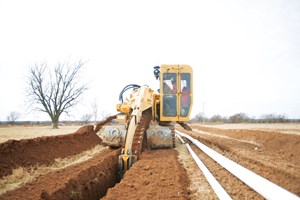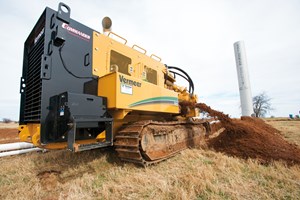May 2020 Vol. 75 No. 5
Features
Rockin' it on Rural Water Project
Deploying a pipeline trencher proves to be the right decision for Built Right Construction
By Diogo Craveiro
When Richard Evans, vice president of Built Right Construction LLC, was approached by a customer a few years ago about bidding on a utility installation job, he thought, “Why not? We have skilled operators and laborers working for us who are committed to making sure everything they do is done right – no matter what the project happens to be.”
The Savanna, Okla.-based general construction company started back in 2006 performing a wide array of work, including highway and building construction, site prep, concrete work, carpentry, excavation and, now, utility installation. The reason for the wide range of disciplines is because the company does a lot of work for the Oklahoma Department of Transportation and is a trusted contractor on federal government projects.
While utility installation is still a new addition to Built Right Construction’s services, demand for this line of work took off quickly. The company recently completed a unique and challenging rural water installation job in Okfuskee County, Okla. Crews installed 8,000 feet of 6-inch CPVC pipe using a Vermeer T655 Commander 3 trencher.
“When we bid the job, we didn’t anticipate there would be much rock in the area and planned to use excavators on the project,” explained Evans. “Before work started, we probed the area and found out we’d be working in rock most of the time. The trench needed to be 4-feet deep, and trying to battle through rock the whole way with excavator buckets certainly didn’t sound like time well-spent for crew members. We needed to find a better way.”
Good timing
For the past several years, southern Oklahoma has been a hotbed for pipeline installation work, with crews using large, “maxi,” horizontal directional drills (HDD) and pipeline trenchers. Evans saw a couple of these trenchers working in the area and knew that’s what they needed for this rural water job. Coincidentally, about the time he started to look around at options, in walked Dusty Warlick, from Vermeer dealer Great Plains.
“Up until this point, we really hadn’t done a lot of utility work, and we certainly had not used anything as specialized as a track trencher,” said Evans. “Dusty happened to be helping another contractor in the area, and we got to talking. He assured me that he could help us get up to speed on operating a trencher, so we rented one for a month.”
The Built Right Construction crew put the trencher to work in the tough Oklahoma rock under the guidance of Warlick. “We spend a lot of time recruiting and training equipment operators, so our team members know their way around machines,” said Evans. “I’m proud to say that with some coaching, we were digging up rock and laying down pipe right out of the gate with that trencher. Even though that machine is large and intimidating-looking, compared to what we typically run, it is incredibly operator-friendly. Within a few days, it was easy for all of us to see how much more productive we were running one trencher compared to running two or three excavators.”
The crew working in the rocky ground was not only outpacing what it could do with excavators, it was also doing the job with fewer people. “In this tight skilled-labor market, doing more with fewer people is a big deal,” Evans added. “We are always trying to balance a lot of projects at once. Employing a trencher allowed us to shift some of our operators to other projects.”
Another thing Built Right Construction’s crew liked about using a trencher is the fine material it produces. Using excavators would have produced chunky material that could not be placed back in the trench as-is for backfilling. The material coming off
the trencher’s conveyer was stacked neatly beside the trench and could be put right back in the ground once the pipe was laid.
Not all smooth sailing
With a dialed-in trencher and crew, the installation of the rural water line progressed quickly – but then the weather took a turn for the worse. Day after day of heavy rains forced the crew to shut down for extended periods. With the rain came a cold front, which also didn’t help the situation.
“It was awful there for a bit, and while we didn’t have a hard deadline, the key to being successful in this line of work is to do a good job and get it done as efficiently as possible,” said Evans. “We were under pressure.”
Even with delays, the crew wrapped up opening the 8,000-foot trench within the month-long rental period. “The footage we got with the trencher was ridiculous,” said Evans. “If the weather would have cooperated, we would have easily had the whole thing opened up in under two weeks.”
In addition to the open trench part of the rural water project, Built Right Construction needed to perform two bores – one under a major highway and the other under Interstate 40. The team subcontracted out that part of the project.
“We’ve just started getting up to speed on horizontal directional drilling,” explained Evans. “While it would have been great to do the bores ourselves, we didn’t feel comfortable crossing under two major roads. We brought in a highly qualified HDD contractor who did an excellent job.”
G&M Contractors performed the work that included a 12-inch highway bore under I-40. The driller also had rock to contend with.
The new water line was connected with a pair of existing rural water lines and two water towers.
Growing utility business
In just two years, utility construction has expanded to represent more than 40 percent of Built Right Construction’s business. The crew has added a Vermeer vacuum excavator to help with potholing existing utilities and intends to add more specialized utility equipment in the future. While not warranted by another job to-date, Evans certainly will rent a pipeline trencher again when needed. •
FOR MORE INFORMATION
Built Right Construction, (918) 548-3766, builtrightok.com
Vermeer Corp., (888) 837-6337, vermeer.com






Comments